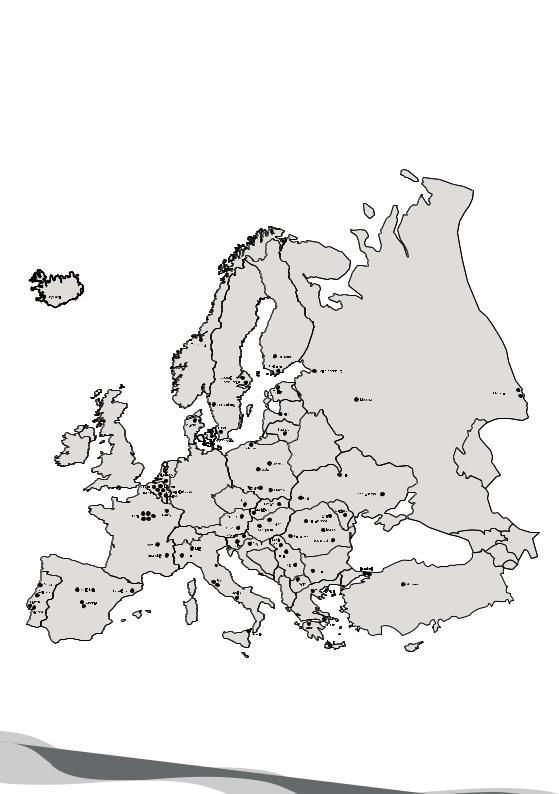
History Book of BEST
.pdf
71
systematically classified. The activities organised by a university would be in this web page as well. To achieve this it was decided at the GA2000 that it will be beneficial for the project if Minerva can have a contact person in each LBG who will provide this information for the web pages.
Later on, in Workshop in 2001 in Cluj-Napoca Specifications for the project were set, however the project froze again. After a “frozen” period, from GA 2002 until PM 2002, the project entered in an active way again. New motivated members showed interest to continue the important work that had already been done. The problems we faced, like licence for the software on which we would develop the database and lack of will from the side of LBGs for help, found solutions during the workshop in Lisbon in December 2002. A new action plan was ready. Certainly our special thanks are going for EduCo committee for the willingness to help and their valuable remarks. It was the third time that the project wasn’t moving on, demotivating the members of the Working Group. This time it lasted till October 2005, when a new Mailing List was again created, to start discussing about possibilities for the project.
“The reason why this project kept being frozen was that it always seemed to develop into something that got out of hand. At least this is what happened since 2005 and the same thing happened before also. The idea was always to make something really simple and easy to fill in. However, the concept always grew into something that was too much for the LBGs to bother with or keep fully updated and ended up de-motivating the people involved.
The reason the XVIII board and coordinators decided to revive the project in 2005 was that there was a university wanting to be sponsor of BEST. They wanted us to promote them like we promote companies on our webpage. The problem was that it would look very strange for us to especially promote one university, which was not even a member of the BEST network, above all the others within the network. So, we wanted to provide some basic means for all the member universities to present themselves for free, while at the same time the same service could be sold to universities that didn’t belong to BEST. So, the aim of reviving University Centre in 2005 was to have universities as sponsors alongside companies.
In 2005-06 we managed to somehow keep the information structure small and push towards fast implementation. The project kept together this time and the implementation was finished by the XIX management. Then again, in some ways idea of the centre got out of hand again. This was never meant to be something compulsory for all LBGs, but simply a tool that helps us fundraise while providing equal opportunities for the BEST universities to present themselves on our pages.” (Elina Seppaen, LBG Tampere)
This is what followed afterwards in short:
•October 2005: creation of the mailing list
•February 2006: Action Plan, Mindmap, and Data Structure is designed
•March 2006: Makumba Data Definitions are coded for the project
•Spring 2006: Coding part starts. The project should have 3 databases (universities, offers, city/student life) but the last part is taken out to be independent and is called European Travel Guide.

Chapter 3:
BEST Online
•GA 2006: End of CaSCo causes the project to freeze till October 2006
•October 2006: LBG Administrators pages ready on ParaDe, first profile filled in there
•November / December 2006: System is launched for testing LBGs. Launch of a competitor (http://www.philox.eu)
•January / February 2007: some feedback implemented, but less profiles than expected are uploaded
•Spring 2007: Promotion at RMs and GA, difficulties to push LBGs
•July 2007: discussions with EduCo and with Regional Advisers. Login for University Representatives is ready! The IT part has all the really basic features implemented
•September 2007: Large promotion towards LBGs
•January 2008: System is launched together with the Unified System
•PM 2008 Bucharest: Proposal to make uploading of University Profile compulsory for LBGs is rejected
•January 2009: 27 University profiles are online
Private Area
The “Private Area” (PA) started from some static web pages in 1995 and progressed to a number of Lotus Notes components in 1998. A new version of the PA was launched in late 2002.
People just realised that it’s impossible to keep such an organisation working when you don’t have the contacts of all the members of it. How could people possibly move on with projects if they didn’t know e-mail addresses or phone numbers of people in the other side of Europe?
The first idea of a centralised contact list of all active BEST members with their possible areas of responsibilities appeared during PM 1995 in Trondheim, and people agreed that it would be made available by the 96 GA, and updated at every GA and PM. This list was indeed available and it was included in the BESTMAG versions that were produced once per year. More over a list was also circulating during GMs. In the beginning of the nineties, many students did not have their own email address, but were contacted through the email of the LBG.
However, BEST realised that such a list in a printed document is not so usable, mostly because information tends to change quite often. For this reason, an on-line way of managing this information was sought.
At GA1998, the Information Technology Strategy Group presented a proposal of how the information should be structured in a database. Information related to BEST members (such as names, e-mail, passwords, study information etc. etc.) was defined and structured. This also involved an archive and a system to apply to internal events.
72

73
During PM1998, ITC presented in their Half Annual Report all the progress that was done till that moment. The new archives system was ready in October of that year, while the new mail exchanger was working since the beginning of November (for the mailing lists). Both systems were based on Lotus Notes. More over, after the GA1998 a BEST registration page was available that was allowing BEST members to apply to internal events.
The Lotus Notes intranet was a great progress for the communication in BEST and sharing of documents, but it was not entirely user friendly. New members rarely used any other part than the internal events application. At the same time, ITC did not have the full control to be able to improve the system. A decision was made to re-implement it with Java / SQL.
More over, they decided to merge the private area with the other BEST systems (Johnny and Minerva) into one, so that people would no longer need 3 passwords to access BEST services, and have keep all their information in one place. The main aim was to stimulate the members to use the Private Area more and give everyone a better overview and tools for interaction.
The new PA was launched in November 2002, with the same content as in the Lotus Notes system, but with a more intuitive way of accessing it:
•The Archive: a repository of official BEST documents, growing with approx 100 documents per year.
•Over 25 document repositories for international groups (e.g. committees, the board).
•International group data management (including over 50 email lists, essential in
BEST communication).
•Support for applying to internal events (WorkShops, statutory meetings) handling yearly around 500 applications to 2 statutory meetings and around 10 smaller events.
•Member’s data with essential contact and other information for all BESTies.
•LBG contact information, with snail mail addresses, phone numbers and
University information.
•Committee pages, for informing BESTies about Committees activities and ways to join them.
Specifically for the archives, a special exporter had been written to fetch all documents with attachments from the Lotus Notes into a new MySQL database.
Since then, a lot of development from ITC side was done, to improve the current features and also to include more. Private Area is the most important tool for the development of the organisation, since it helps all the communication between BEST members, gathers the knowledge and gives useful information for all aspects of the organisation. Since 2002, the system didn’t get any radical change but here is a list of features that were added since then:
•Availability tool
•Wiki pages support

Chapter 3:
BEST Online
•Task management
•[BAS|BEST.BAS] LBG Area
•Surveys
•Project management
•Company Database
•Refunds request tool
•Accounting tool
•E-mail archives
•And many many more
Newsletters
Newsletters are a way of reaching a lot of people at the same time, informing them about new services, opportunities or developments, without the fear of ‘spamming’ them. This fear is eliminated by asking the user if it is okay with getting this information to his/her mailbox every now and then.
Newsletters appeared in BEST in the 90’s for the first time, when BEST was sending information about the events to people that were subscribed to it.
In 2005 Newsletter capability was added in BEST Career Centre, and information about career events, openings in companies and internship possibilities were sent to students that were subscribed.
Unified System
When the BEST online systems - Johnny/BAS, Minerva/BCC and Private Area - where reprogrammed in Makumba and launched in 2002, each system still had their own separate log-in. From the start of Makumba development (2001), the designers in ITC had planned to merge these systems into one - using only one log-in. This would require a “merger” - bringing all the data together and deleting duplicate data. At the same time it needed to be intuitive for the users and ITC needed to ensure that no data would be lost. The first designs of this merger tool were made in WS Trondheim in 2001, but it took until 2003 for the first programming to start. However, it turned out more complicated and expected - the design had to be rethought several times as there were many issues regarding access and visibility of information. In 2004 it was decided to focus the first merger on BESTies only. BESTies would understand if their accounts did not function properly for a while or if some data error would happen, whereas any error could be damage our image to the external world. After intense programming and testing, the merger could finally be presented at the GA 2005. BESTies were invited to enter and merge all their accounts into one. After that, all new BEST members would have only one account, giving access to all BEST systems while having the personal data accessible on one page. However, the non-BESTies still needed separate accounts to access to BEST services. It took until 2007 for the unification process to begin...
While the idea itself is older, the actual design for unifying all the services we offer to
74

75
students (on our website) started in the beginning of 2007. After GA 2007, all committees were involved in the work of restructuring the public pages, while ITC focused mainly on implementing the new system. The project was developed during several events (Budapest
Developers Meeting, Vienna Unification Meeting and ITC Winter Meeting Eindhoven), while various IT tasks were handled on the mailing list.
New features were implemented:
•New visual design, also improved with a site-wide search engine (added after the launch)
•Students require only one account for all parts of our system, including a single set of pages for viewing and editing the personal information
•Dedicated public pages for different users (student, academic, company), with a universal login that redirects to the appropriate account directly
•Redesigned interface for the academic account (contains both the University
Centre representative and the BAS professor account details)
•Unified administration of student accounts, for BAS and PA administrators
(added after the launch)
The new system was launched as planned, in January 2008. Apart from a couple of minor bugs, everything went fine with the launch and developers have kept improving the system since then. There are many more ideas of which ITC will keep track of and they will be considered individually for future implementation.
Also in January 2008, the new website went through a usability study at the Technical University of Copenhagen (Denmark). Four groups of students tested and provided extensive feedback for the public pages and the student account. This report was analysed by ITC and the suggestions were added next to the other improvement ideas.
Public Website
The public website is the compilation of pages that provide information to the public about our organisation. This information can be either about our activities, or services, or internal news, like elections or decisions made.
Having said all these, the Public Website is a very useful tool to spread the information about
BEST into the public. The first public website of BEST appeared in 1995.
Frederic Ranno made the first BEST WWW pages. He is from Grenoble but studied also abroad in Newcastle where the pages were hosted. Ovidiu Sandor took over the WWW pages in Stockholm at some point (the pages were stored at www.nada.kth.se/~ovidiu/ best, which still exists!).
In 1997 we had the new web design of BEST, which was financially supported by the H3E
Thematic Network. This year the domain ‘best.eu.org’ was also obtained and used.
“As you see hosting WWW pages was a project itself, and has some history. I remember a big meeting in early 1997 when we (Ovidiu, me, Olivier Cuisenaire who was also a SPOC member interested in the optimization) ported all the best pages to JML and launched www.

Chapter 3:
BEST Online
best.eu.org, that’s when the hosting by Ovidiu stopped even if machines at NADA were still the main infrastructure. Then we left everything to webmasters (Dani Buxerres came in quite soon after).
About infrastructure, an important step came at GA Stockholm in 2000 when we managed to move systems out of NADA to a computer (called Malaka) bought by BEST Luleå and left under the table of BEST Stockholm.
There existed also an FTP server a long time ago (since 1993) in Patras, maintained by Akis Karnaussos. It was deprecated down after the WWW archives started being used.” (Cristi Bogdan, LBG TImisoara)
How the webpage looked like in 25th of January 1999: [http://web.archive.org/ web/19990125093623/http://www.best.eu.org/]
This design was kept in BEST till May 2001, when the new design was made and in 2003 a news engine was added in the public website. This way, people could update easily the front page with short news and with information about the organisation.
How the webpage looked like in 22nd of May 2001: [http://web.archive.org/ web/20010522001453/http://www.best.eu.org/]
How the webpage looked like in 19th of October 2003: [http://web.archive.org/ web/20031019003553/www.best.eu.org/index.jsp]
At the end of next year (2004), the public website is again redesigned and launched for the public.
How the webpage looked like in 12th of January 2005: [http://web.archive.org/ web/20050121033143/www.best.eu.org/index.jsp]
Last time the website was redesigned was in January 2008. This time, it was a big milestone for BEST, because the dream of merging of all BEST systems was finally achieved! The new website was a Unified System that was merging the BEST Application System, BEST Career
Centre and the BEST Teachers’ Area, making possible to promote only one website in all our stakeholders.
76

History Book of Board of European Students of Technology |
1989-2009 |
Chapter 4
BEST Network
•Stories of the LBGs
•Regions

Chapter 4:
BEST Network
BEST Network
78

79
Event/LBG |
Date/new status |
Event/LBG |
Date/new status |
|
|
|
Brno Full Member |
|
|
PM2009 Lviv 11 November 2009 |
Moscow Baby Member |
|||
|
|
Nis Observer |
|
|
GA2009 Budapest 23 April 2009 |
Novi Sad Full Member |
|||
Aveiro Excluded |
|
Reykjavik Full Member |
||
ENSTA ParisTech |
Full Member |
|
|
|
Lyon Suspended |
|
Valencia Excluded |
|
|
Nis Full Member |
|
Valencia Observer |
|
|
Saint Petersburg Baby Member |
Zaporizhzhya Observer |
|||
|
|
Zaporizhzhya Baby Member |
||
PM2008 Bucharest 12 November 2008 |
|
|
|
|
Aveiro Observer |
|
PM2006 Ghent 19 November 2006 |
||
ENSTA ParisTech Suspended |
Ankara |
Baby Member |
||
Kiev Baby Member |
Ankara |
Observer |
|
|
Kiev Observer |
|
Brussels ULB |
Baby Member |
|
Messina Baby Member |
Graz |
Baby Member |
||
Saint Petersburg Observer |
Kaunas |
Full Member |
||
Zaporizhzhya Full Member |
Madrid Carlos III |
Baby Member |
||
|
|
Moscow Observer |
|
|
GA2008 Tallinn 07 May 2008 |
|
|
|
|
Ankara Full Member |
GA2006 Zagreb 27 April 2006 |
|||
Brussels ULB Full Member |
Brussels ULB |
Observer |
||
Cambridge Observer |
Ekaterinburg, USTU Full Member |
|||
Cambridge Excluded |
Graz |
Observer |
|
|
Chisinau Baby Member |
Novi Sad Baby Member |
|||
Graz Full Member |
|
Reykjavik Baby Member |
||
Istanbul, Yildiz Observer |
|
|
|
|
Istanbul, Yildiz Baby Member |
PM2005 Ljubljana 14 November 2005 |
|||
Messina Observer |
|
Aalborg |
Full Member |
|
Sarajevo Excluded |
Brno |
Baby Member |
||
|
|
Gdansk |
Full Member |
|
PM2007 Valladolid 11 November 2007 |
Istanbul Full Member |
|||
Aalborg Suspended |
Madrid Carlos III |
Observer |
||
Chisinau Observer |
|
Novi Sad Observer |
||
Kiev Observer |
|
Reykjavik Observer |
||
Kiev Excluded |
|
Rome, Tor Vergata Full Member |
||
Madrid Carlos III |
Full Member |
|
|
|
Nis Baby Member |
|
GA2005 Greece 23 April 2005 |
||
Sarajevo Observer |
Brno |
Observer |
|
|
GA2007 France 21 April 2007 |
Kaunas |
Baby Member |
||
Aalborg Suspended |
Lviv |
Full Member |
||

Chapter 4:
BEST Network
Event/LBG |
Date/new status |
Event/LBG |
Date/new status |
||||
PM2004 Portugal 16 November 2004 |
Lviv |
Observer |
|
|
|||
Aalborg |
Suspended |
|
Lyon |
Observer |
|
|
|
Almada |
Full Member |
|
Maribor |
Baby Member |
|
||
Belgrade Full Member |
|
Nancy |
Baby Member |
|
|||
Ekaterinburg, USTU Baby Member |
Skopje |
Observer |
|
|
|||
Gdansk |
Baby Member |
|
Vienna |
Observer |
|
|
|
Istanbul |
Baby Member |
|
|
|
|
|
|
Lulea |
Excluded |
|
|
PM2001 Madrid 12 November 2001 |
|||
Lyon |
Full Member |
|
Aalborg |
Full Member |
|
||
|
|
|
|
Nancy |
Observer |
|
|
GA2004 Copenhagen 11 April 2004 |
Paris, Polytechnique |
Full Member |
|||||
Kaunas |
Observer |
|
|
Thessaloniki |
Full Member |
||
Vienna |
Full Member |
|
|
|
|
|
|
|
|
|
|
GA2001 Ljubljana 15 April 2001 |
|||
PM2003 Belgium 04 November 2003 |
Iasi |
Baby Member |
|
||||
Belgrade Baby Member |
|
Leuven |
Baby Member |
|
|||
Gdansk |
Observer |
|
|
Maribor |
Observer |
|
|
Istanbul |
Observer |
|
|
|
|
|
|
Maribor |
Full Member |
|
PM2000 Budapest 13 November 2000 |
||||
Nancy |
Full Member |
|
Aalborg |
Baby Member |
|
||
Rome, Tor Vergata Baby Member |
Brasov |
Full Member |
|
||||
Skopje |
Full Member |
|
Iasi |
Observer |
|
|
|
|
|
|
|
Leuven |
Observer |
|
|
GA2003 Slovakia |
14 April 2003 |
Paris, Polytechnique Baby Member |
|||||
Almada |
Baby Member |
|
Sofia |
Baby Member |
|
||
Belgrade |
|
Observer |
|
Sopron |
Full Member |
|
|
Ekaterinburg, USTU Observer |
Uppsala |
Full Member |
|
||||
Lviv |
Baby Member |
|
|
|
|
|
|
Lyon |
Baby Member |
|
GA2000 Sweden 23 April 2000 |
||||
Rome, Tor Vergata Observer |
Aalborg |
Observer |
|
|
|||
Sopron |
Excluded |
|
|
Ekaterinburg |
Full Member |
||
Vienna |
Baby Member |
|
Kiev |
Observer |
|
|
|
|
|
|
|
Lyon |
Baby Member |
|
|
PM2002 Bucharest 09 November 2002 |
Paris, Polytechnique |
Observer |
|||||
Almada |
Observer |
|
|
Saint Petersburg |
Excluded |
|
|
Skopje |
Baby Member |
|
Sofia |
Observer |
|
|
|
Sofia |
Full Member |
|
Thessaloniki |
Baby Member |
|||
|
|
|
|
Zagreb |
Full Member |
|
|
GA2002 France 15 April 2002 |
|
|
|
|
|||
Iasi |
Full Member |
|
PM1999 Chania15 November 1999 |
||||
Leuven |
Full Member |
|
Brasov |
Baby Member |
|
||
80
